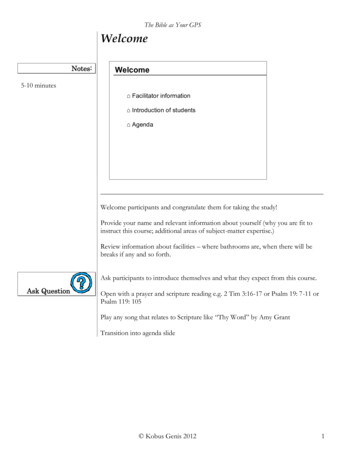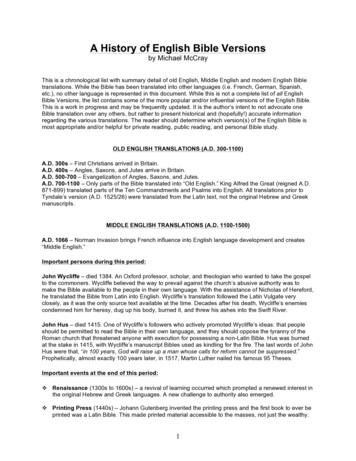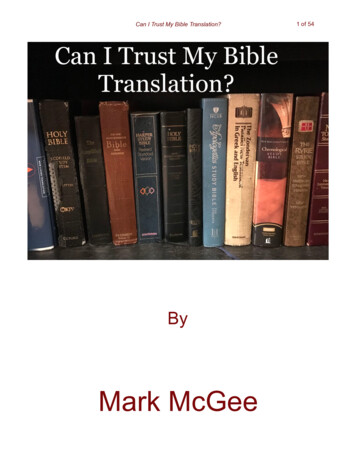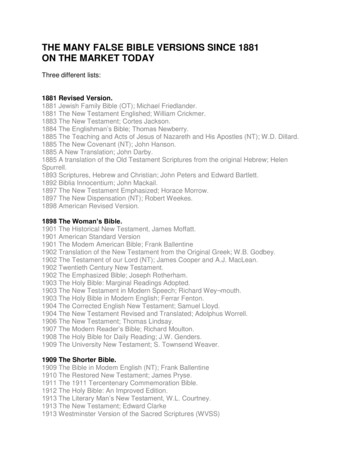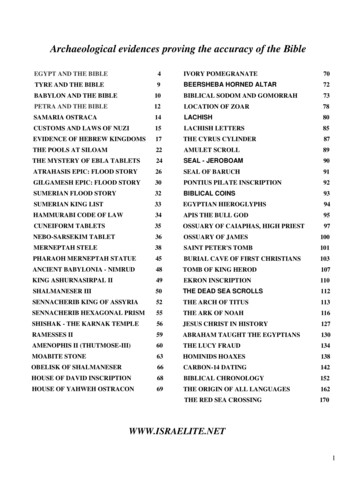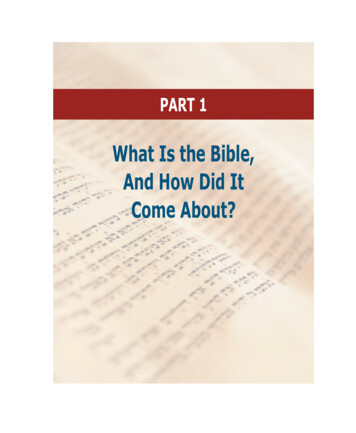
Transcription
PART 1What Is the Bible,And How Did ItCome About?
ABCDELOCATING THE BIBLICAL WORLD11E UROP EAS I A22PACIFICOCEANIndiaA FRICA33ATLANTICOCEANArea of Detail in Map 1.2INDIAN OCEANN4400A16008002400 Miles800 1600 2400 KilometersBCDEBCDEMAP 1.1AM1Riv erisntTRiveresatcehrN i l e V a l ley1esEupTHE WORLD OF THE BIBLEedAFP 18iterraEurasia/Africa LocatorneanThird ProofSeFeratile09/18/09CCANAANrv erigrRirsianWhiulfivINDIAInd us ReIn rduGeaR ed S3Blue Nilete Nil eCUSH2sValleyPeeNil23Arabian Sea44N00ABC400200600 Miles200 400 600 KilometersDEMAP 1.2The “Fertile Crescent” is the name given to the rich arable land in Mesopotamia and theNile Valley, where ancient civilizations first developed. The area shaded yellow aroundLake Victoria is where the oldest known human fossils have been discovered.AFP 18Garden of Eden Version 24th Proof08/07/08
1The BibleA Gradually Emerging CollectionIN THIS CHAPTER, YOU WILL LEARN ABOUTP The process of canonization of the BibleO Hebrew BibleO New TestamentP Why communities need a canonP The criteria writings needed to meet for admission to the NewTestamentWunderstanding life in this technological age?These all-important questions deserve clearand careful answers.The Bible has been and can be an extremelyvaluable resource as we try to understand ourlives today and try to find meaning in a fragmented world. In this book I try to understandthe Bible in its own context, coming to see whatunderstandings of God, the world, humanity,and God’s people the Bible contains. Only afterwe have done that can we decide whether thoseunderstandings have something to offer twentyfirst-century readers.hile most of us recognize a Biblewhen we see one, we often do notstop to consider just what it contains. What kinds of writings are in it? Howdid it get to us? Why are translations so different? We often hear questions of a differentsort, questions about whether the Bible is truewhen it says the world was created in six daysor that Jesus stopped a raging storm. What arethose of us in a world dominated by a scientific outlook to think about such things in theBible? How can an ancient book that seems toview the world so differently be valuable for3
4What Is the Bible, And How Did It Come About?P The Bible: A CollectionThe Bible is not a single book, but a collectionof over sixty different writings composed bymany different authors over hundreds of years,written in three languages: Hebrew, Aramaic,and Greek. The Bible also includes many different kinds of writings: narratives, letters, psalms,poetry, and an “apocalypse,” to name a few.Some of its books have multiple authors—forexample, the Gospel of John. Near the end ofJohn, this statement appears: “This is the disciple who is testifying to these things and haswritten them, and we know that his testimony istrue” (John 21:24).Notice the “we” in this verse. This sentenceshows clearly that a group of people beyond theoriginal “disciple whom Jesus loved” (whomthis verse names as the source of the material inthe book) had a hand in composing this Gospel.“We know” that what this disciple said is true.So even some books that we often think of aswritten by a single person had a more complexorigin than just a solitary author composing athis or her desk.BOX 1.1LOCATING MATERIAL IN THE BIBLEBooks of the Bible are divided into chapters and verses. These divisions are usedto locate particular passages within thebooks. The regular way the divisions arewritten is chapter number, colon, versenumber. For example, chapter 21, verse24 is written 21:24.P The Emergenceof the CanonThe process of collecting the various writingsinto a single book took several centuries, andthe decisions about which books would constitute the Bible involved a great deal of thoughtand discussion. In the end, the thirty-nine booksof the Protestant Old Testament (the HebrewBible counts the same writings as twenty-fourbooks by combining pairs of books like 1 and 2Samuel into one and the Twelve Minor Prophets into one; see also the discussion of the Apocrypha below) and the twenty-seven books of theNew Testament were the writings in which thefaith communities heard the voice of God in adistinctive way, a way that led them to designatethese books as authoritative guides for theirlives and beliefs.The term canon designates a collection ofwritings that carries authority in a given religious community. The English word canoncomes from the Greek kanon, which means ameasuring stick. The canon is the standard bywhich a religious community evaluates beliefs,practices, and ethical behavior. We may wonderwhy anyone would want such a standard. Whynot let each person determine what is right?Even if you decide that you want a standard,how do you decide what it is? Who decides?Why Standards?While it seems to run counter to our desire forfreedom of thought and action, every groupmust have standards; without them there can beno group. They may be an aggregation of people in a single location, but without things thatbind the people together, they are not a group.
CHAPTER 1Every group must have a purpose and agreeupon means of working toward that purpose.Bridge clubs, poker groups, and political movements all have agreed-upon purposes and rulesby which they conduct themselves. Sometimesthose rules are explicit and sometimes theyare implicit, but they are always there. Just tryhiding a card up your sleeve if you think yourpoker group doesn’t have rules! Likewise, allreligious groups must have some guide for theirbeliefs and practices. Without those, you haveno reason to come together as a religious group.Boundaries. Not only do all religious groupsneed a guide for their beliefs and practices, theyalso need means of determining their boundaries.Every group must have ways to determine whois in and who is out. Again, without boundaries,you do not have a group, because being all-inclusive renders membership meaningless. The earlychurch and Second Temple Judaism neededboundaries that set them off from the polytheistic world, and even from each other. They neededways to determine what their identity was to be.Determining what your identity is includesclarifying who you are not. So groups needsome means of rejecting beliefs and practicesthat violate their core beliefs. This does notmean that people within the group must benarrow-minded, only that they need ways tobe clear about who they are. If you belong toa group that has openness or inclusiveness asa central value, you cannot allow a person whosuccessfully works at excluding as many peopleas possible to be part of your group. Everyonemust draw boundaries. This task is particularlyurgent when the group faces opposition or persecution, because people want to be clear aboutwhat they are willing to suffer for.The Bible5BOX 1.2SECOND TEMPLE JUDAISMSecond Temple Judaism refers to theforms of Judaism that existed fromapproximately 515 b.c.e. to 70 c.e. Thisperiod begins when the temple in Jerusalem was rebuilt after it had been destroyedby the Babylonians in about 587 b.c.e. andends with its destruction in 70 c.e. by theRomans.P The Canon of the HebrewBibleLike all groups, Second Temple–period Jewsand early Christians needed authorities to whichthey could appeal when there were disputesabout their identity, about what they shouldbelieve, and about how they should live. Bothgroups turned to books as their guides. So boththe Jewish community and those who believedin Christ developed a canon, a set of authoritative writings. I will first sketch how the canon ofthe Hebrew Bible developed, and then turn tothe New Testament.A Complicated ProcessThe process of collecting the books of theHebrew Bible was complicated. First, many ofthe books show evidence of having been written by more than one person and of drawing onother written sources for some of their content.Indeed, some of the books seem to have incorporated material written hundreds of years beforethe texts we now have came together (we willdiscuss this in more detail in subsequent chapters). Many of the books of the Hebrew Bible are
6FIGURE 1.1What Is the Bible, And How Did It Come About?THE WESTERN WALL OF THE TEMPLEThis wall is the most intact part of Herod’s Temple that remains. The sanctuary of the temple and thearea for sacrifices stood above this wall. The Romans destroyed the other parts of the temple complexin 70 c.e. when they sacked Jerusalem to end a revolt. Gettyopen about drawing on other sources for material. They tell you to read those other books ifyou want to know more about the subject theyhave been discussing. Here are a few examples ofthe many places where the text sends the readerto consult such works and gives their names:1 Chronicles 9:1:“the Book of the Kings”1 Chronicles 29:29:“the Book of Samuel”Deuteronomy 17:18-19:“the king is to keep a copy of this law”Numbers 21:14:the Book of the Wars of the LordJoshua 10:13:“the Book of Jashar”1 Kings 11:41:“the Book of the Acts of Solomon”These notations suggest that the writers ofthe biblical texts take what they find in otherbooks and give them a religious or theologicalinterpretation. The biblical writers interpret theevents of the nation’s past so that those eventsreveal something about the people’s relationship
CHAPTER 1BOX 1.3DESIGNATIONS OF YEARSThe common scholarly conventions for thedesignations of the eras have changed sothat it is more inclusive. The designationb.c. (Before Christ) has been replaced byb.c.e. (Before the Common Era) and a.d.(Anno Domini; in the year of our Lord) hasbeen replaced by c.e. (Common Era), thetime when both Judaism and Christianityexist.with God. In addition to the texts that retellIsrael’s national story, the books attributed toprophets were often completed only after theprophet’s death. One clear indication of thisprocess of writing is that they often refer to theprophet in the third person rather than in thefirst person; that is, the prophetic books oftensay the word of the Lord came to him, ratherthan saying it came to me.“The book of the law.” Since many of thesebooks were composed by multiple writers andsometimes rewritten over centuries, we shouldexpect that gathering them into a single volume was also complex. The process did not getstarted as early as we might think. There wasno large collection of authoritative books thatIsraelites could consult until about the sixthcentury b.c.e. The story of King Josiah (640–609) shows how late the process of gatheringthese books started. In 2 Kings 22:8-13 we hearthat Josiah commissioned a refurbishing of theneglected temple of God in Jerusalem. Duringthe renovations, workers found “the book ofthe law” in a back room of the temple. WhenThe Bible7some officials read this newly discovered book,they became aware that they had not been livingby its commands at all. Worried about this stateof affairs, they called on a prophet, Huldah, toverify that the book really was the word of God.After she confirmed that it was, Josiah began asweeping reform based on what this text commands. Though it might seem unbelievable tous, this story says that during Josiah’s reformthe people kept the Passover for the first time inthree hundred years (2 Kgs. 23:21-23).This story shows that the Israelites did notpossess an extensive collection of writings byMoses or anyone else that gave instructions onhow they should live and worship. They foundthis one book and were surprised by its instructions. So the process of developing a canon, agroup of authoritative writings, did not beginuntil some time after this point. It is important tonote that this story took place in about 620 b.c.e.,only about thirty-five years before the kingdomof Judah fell. This means that the work of assembling the canon began in earnest during the exile.Developments after the ExileWhen Judah (the second of the two Israelitenations) fell in 587 b.c.e., a large part of thepopulation was forced to migrate to Babylon(located in today’s Iraq). While Judah was inexile, the Babylonian Empire fell to the PersiansBOX 1.4Read 2 Kings 22:8-10. What does thispassage suggest about the authority ofprophets in ancient Israel? What does itsuggest about the status of women whopossess this gift?
8What Is the Bible, And How Did It Come About?(located roughly in today’s Iran). The Persians’policy concerning regions in the more distantparts of the empire differed from that of theBabylonians, so they allowed the people ofJudah to return to Jerusalem around the year539. The Persians granted the Judahites andother distant regions permission to governthemselves by their ancestral laws.Ezra and the “book of the law of Moses.”The first evidence for a collection of authoritative books within Judaism appears as thepeople of Judah returned from exile and beganthe process of semiautonomous governance.The book of Nehemiah tells about the returnBOX 1.5Read Nehemiah 8:1-8, 13-18. Notice themention of the leaders and how they functioned on this occasion. How do you thinkthe writer wants readers to understandthe place of the Law in ordering society?of some exiles and the establishment of the lawof the land. It says that the priest Ezra gatheredthe people in Jerusalem and read to them the“book of the law of Moses” (Neh. 8:1-3). WhileNehemiah describes the book as what God gaveMoses, there is no evidence that it existed inwritten form, particularly in the form that Ezraread, until sometime during the exile. Afterall, before they found it in a back room of thetemple, neither the king nor the temple’s priestsknew of its existence at the time of Josiah, theking who reigned just a few years before the firstwave of the exile. Yet when the exiles return justabout eighty years later, they possess a collection of writings by which they can govern theirreligious and civic lives.The three parts of the Hebrew Bible. WeFIGURE 1.2TORAH SCROLLEarly eighteenth century. Art Resourcedo not know what was in the collection fromwhich Ezra read, but it probably includedmuch of what is now in the Pentateuch, the firstfive books of the Bible. These books are calledthe Torah in the Hebrew Bible. Other bookswere collected and began to be revered over thenext two hundred fifty years. By the mid-secondcentury b.c.e. the book called Ecclesiasticusor Sirach (part of the Apocrypha) could referto a collection of writings divided into threegroups: “the Law, the Prophets, and the otherbooks,” very close to the divisions of books ofthe Hebrew Bible still used today. While some
CHAPTER 1discussion continued about which books shouldbe included, and some included books were stillbeing reedited, the basic contours of the collection were in place at this point.The Dead Sea Scrolls. Until the discovery ofthe Dead Sea Scrolls in 1947, our earliest extensive Hebrew manuscripts of the Bible camefrom about 1000 c.e. Among the Dead SeaScrolls are copies of at least part of the HebrewFIGURE 1.3The Bible9text of every book in the Hebrew Bible exceptEsther. These copies were made just before andduring the time of Jesus. For the most part, thescrolls demonstrate the care with which thecopyists preserved the ancient text. But in somecases, we can see the ways that some books ofthe Hebrew Bible were still under construction.For example, some of copies of Jeremiah foundamong the scrolls are like the longer text in theGreek translation, others like the later acceptedQUMRANOne of the caves in which the Dead Sea Scrolls were discovered, near Qumran. Among the Scrolls arecopies of portions of every book in the Hebrew Bible except Esther.
10FIGURE 1.4What Is the Bible, And How Did It Come About?SECTION OF A SCROLL FROM QUMRANThe Dead Sea Scrolls give us some of our best evidence for the form of the Hebrew Bible’s text in thefirst century. This is a section from the Isaiah Scroll. Art ResourceThe Completion of the Canon of theHebrew Biblesecond century b.c.e. That translation includedall the books now found in the Hebrew Bible(Old Testament) and the books often called theApocrypha. Many Jews viewed these books asauthoritative, at least in some way.* While thelist was not completely decided upon, thereOur other most important evidence for understanding what Jews were reading as guides fortheir religious life is the Septuagint. The Septuagint is a translation of the Hebrew Bible intoGreek that was completed near the end of the*There were disagreements among different groupsabout which books were authoritative. For example,Sadducees accepted only the Torah as authoritative, while Pharisees accepted all thirty-nine books asauthoritative.biblical text, and another has different expansions so that it is significantly longer than thatfound in the Bible today.
CHAPTER 1was wide enough agreement about its contentthat first-century Jews could refer to the Torah,Prophets, and Writings, confident that otherJews knew what they meant. The first-centuryJewish historian Josephus could refer to thebooks of Scripture. His accounting seems toamount to the thirty-nine books now in theHebrew Bible. While there was a wide andbroadening consensus about which books toinclude in the canon, there was no definitivedelimiting of the canon until the end of the firstcentury c.e. Before its destruction in 70 c.e., thetemple had been a vitally important element indefining what it meant to be Jewish. Once it wasdestroyed, these texts (and their interpretation)became the central guide for determining whatit meant to be a faithful Jew. Thus the canon ofthe Hebrew Bible was the result of ten centuriesof work and thought.The Bible11Orthodox Bible includes two additional books,3 Maccabees and 2 Esdras, books also preservedin Greek and known widely in the early church.The earliest Christian writings. The Septua-gint was not only the early church’s first Bible,but also nearly its only Bible through the firstcentury. The earliest book of the New Testament(probably 1 Thessalonians) was not written untilaround 50 c.e. The latest of the New Testamentbooks (probably 2 Peter) was composed around125. The books of the New Testament also comefrom many different authors, and a number ofthem are written anonymously. Paul wrote hisletters, the earliest writings in the New Testament, between the years 50 and 65. The NewTestament Gospels began to be written soonafter that and were probably all written by theyear 100. By then, there were already collectionsof Paul’s letters to churches circulating amongthe early communities of Christ believers.P The Christian CanonThe question of authority. From the earliestThe Protestant Old Testament contains thesame books as the Hebrew Bible, though theyappear in a different order and are numbereddifferently. The Roman Catholic Bible includesas deuterocanonical the books called the Apocrypha. These seven books plus additions toDaniel and Esther were part of the Septuagint.2Later Judaism did not include these books in itscanon, in part because most were not originallywritten in Hebrew. They remained within thecanon in some parts of the Christian traditionbecause they were in the Septuagint, the translation of the Hebrew Bible that was the primaryBible of the early church. Furthermore, thepresence of these books in the Septuagint led totheir inclusion in the Vulgate, the fifth-centurytranslation of the Bible into Latin. The Greektime after the death and resurrection of Jesus,the apostles were the central authorities withinthe church. The church needed to know morethan simply what Jesus said or did and howhe had died; they needed to know what thesethings meant. Knowing specific facts about thelife of Jesus was less important than being ableto interpret those facts in a way that was appropriate to what the church confessed about him.From the earliest times, the apostles were thepeople that the church saw as authorized tointerpret the life, teaching, death, and resurrection of Christ. Many interpretations of thelife of Jesus were current in the first century:some saw him as a great reformer within Judaism, others as a political rebel, and still othersas a misguided artisan. These interpretations
12What Is the Bible, And How Did It Come About?CHART 1.1THE CANONS OF THE TANAKH (JEWISH BIBLE)AND THE CATHOLIC AND PROTESTANT OLD DeuteronomyProphetsFormerJoshuaJudges1 Samuel2 Samuel1 Kings2 KingsLatterIsaiahJeremiahEzekielThe rbsJobSong of SongsRuthLamentationsQoheleth (Ecclesiastes)EstherDanielEzra-Nehemiah1 Chronicles2 ChroniclesCATHOLIC OLD uteronomyHistorical BooksJoshuaEzraJudgesNehemiahRuthTobit1 SamuelJudith2 SamuelEsther (includ1 Kings ing Greek2 Kings portions)1 Chronicles 1 Maccabees2 Chronicles 2 sSong of SolomonWisdom of SolomonSirach Baruch (including the Letter ofJeremiah)EzekielDaniel (including the Prayer ofAzariah and the Song of theThree Young Men, Susanna,and Bel and the aggaiJonahZechariahMicahMalachiPROTESTANT sDeuteronomyHistorical BooksJoshuaEzraJudgesNehemiahRuthEsther1 Samuel2 Samuel1 Kings2 Kings1 Chronicles2 esSong of haniahHaggaiZechariahMalachi
CHAPTER 1CHART 1.2THE DEUTERO-CANONICAL BOOKSOF THE ROMAN CATHOLIC CANON(AND THE PROTESTANTAPOCRYPHA)TobitJudithWisdom of SolomonEcclesiasticus (Sirach)Baruch (including the Letter of Jeremiah)1 Maccabees2 MaccabeesIn addition to these seven books, the Protestant Apocrypha also includes1–2 EsdrasAdditions to Esther*Letter of Jeremiah*Prayer of Azariah and the Song of the ThreeYoung Men*Susanna*Bel and the Dragon*the Prayer of Manasseh*These writings are included within other canonical booksin the Catholic canon, but are separate writings in the Protestant Apocrypha.rested on the same facts the church had aboutthe ministry and death of Jesus. The questionwas not what happened, but what those actions,particularly Jesus’ death, meant.Apostolic authority. Our earliest accountsagree that the church relied on the apostles forthe proper interpretations of the life, ministry,death, and resurrection of Jesus. They assertedthat he was genuinely God’s Messiah (literally“annointed one”; in Greek, Christos) or Messiah designate. Though it was nearly impossibleto believe, given how his life ended, Jesus wasthe one in whom God had chosen to be present among God’s people and to initiate the endThe Bible13times. Understanding the resurrection as God’svindication of Jesus’ teachings, life, and deathmakes this interpretation plausible. It was thoseclosest to Jesus, the Twelve, who the church saidmost clearly understood the meaning of his life,death, and resurrection. To these twelve disciples the church added Paul, because he had adirect experience of the risen Christ, and James,the brother of Jesus, who became the leader ofthe Jerusalem church around the year 44 or 45.The need for authoritative writings. In theearliest years of the church’s existence, whensomeone wondered what a person who confessed Christ should do or believe, they wouldask an apostle. What does Peter say this actionof Jesus means? What does James say this saying of Jesus means? What does Paul say Christbelievers should do in this situation? But by65–70 many, probably most, of the apostles haddied. Then the churches turned to those whoknew the apostles best, but soon those associates of the apostles gave different answers whenasked what an apostle would have told themto believe or do. (Of course, the apostles hadthemselves also given different kinds of answersto the same questions.) Since various leadersgave so many, and even contradictory, answersthe church began to look to written sources forguidance. Then the question became, whichwritings have apostolic authority?The church also felt the need to identifya set of authoritative writings because therewere competing and mutually exclusive formsof Christianity. In the second century therewere Gnostics, Marcionites, and Montanists,to mention just a few. Since these groups hadcontradictory teachings, the church needed anauthoritative guide for its beliefs and practices.
14What Is the Bible, And How Did It Come About?BOX 1.6INTERPRETATIONS OF JESUSThe range of interpretations that mighthave been given Jesus’ ministry can beseen by a few examples from reports in theNew Testament. Mark 3:19-27 reports thatsome who saw Jesus’ miracles thought hewas empowered to do them by the devil.Acts 5:33-39 tells of people who claimedto be called by God to oppose the powerstructure and who gathered followersand had political aspirations. They were,of course, defeated by the Romans. TheGospel of John has the people in chargein Jerusalem say the Romans will seeJesus as a political threat (11:45-51). So awide range of interpretations of the life ofJesus appeared even during his lifetime.They believed that some of these teachingsdenigrated human life and the God of Israel, sothey sought a means to reject such teachings.The first Christian canon. Not only were thereteachings that the main body of the churchrejected because they were dangerous, but in atleast one case someone put together a canon thatmost found unacceptable. In the first half of thesecond century, Marcion went to Rome, wherehe made a bid to become a bishop. He taughtthat the God of the Hebrew Bible was not theFather of Jesus Christ. The God of Israel, hesaid, was too violent and vindictive to be theloving Father revealed by Jesus. He thereforerejected the whole Hebrew Bible and acceptedonly Luke as his Gospel (which he edited tosuit his theology). He proposed that his editedversion of Luke and ten (edited) letters of Paulserve as the body of authoritative writings—thecanon—for the church. The larger body of thechurch rejected Marcion’s theology and canon.They insisted the God of Israel was the Fatherof Jesus Christ and defended the authority ofthe Hebrew Bible as well as that of the Gospelsof Matthew, Mark, and John.The criterion of apostolicity. As the churchbegan to assemble a group of authoritativetexts, the most important characteristic a writing needed to be included among them wasapostolicity; that is, it had to be written by, orrelated in some other way to, an apostle. Sincethe apostles had been the authorities within thechurch from its inception, the church looked totheir writings as guides once the apostles themselves were no longer available. They saw thePauline letters as clearly apostolic, but Matthew,Mark, and Luke were all written anonymously.Very soon after their composition, however, traditions grew up that attached each to an apostle:Matthew was said to be written by the apostleMatthew; Mark was written not by an apostlebut by a disciple of Peter who wrote what PeterBOX 1.7APOSTOLICITYSome connection to an apostle was oneof the most important criteria for a writing to be considered authoritative as theChristian canon emerged. It was important that a book be written by one of theTwelve or Paul or James—or by someoneclosely associated with one of them.
CHAPTER 1preached about Jesus; similarly, Luke was written by an associate of Paul.These traditions probably do not recordactual historical connections to those apostles,but they do demonstrate the importance thechurch placed on relating each authoritativebook to an apostle. The introductory words ofthe book of Jude exemplify the importance thechurch placed on a connection to an apostle.Jude identified himself as the brother of James.If he was the brother of James, he was also thebrother of Jesus. But Jude made no claim to thatimmediate connection to Jesus, because thatwould not have established his authority the waya connection to the apostle James did. It is notsimply what Jesus said or did that was authoritative, but the meaning the apostles gave to whatJesus did or said that mattered. So Jude had toattach himself to an apostle to get a hearing.Common usage and coherence. In additionto needing an apostolic connection, a writingalso had to be known and used widely acrossthe Christian world. A text known primarilyin Asia Minor (today’s Turkey) or Egypt didnot achieve the prominence needed to becomeauthoritative for the whole church. Furthermore, for the wider church to begin accepting abook as genuinely apostolic, it had to agree withwhat later would be called the “rule of faith.”That is, its content had to cohere with the rangeof beliefs that the early church accepted.The Closing of the Christian Canon:A Gradual ProcessThere was no one moment in the early churchwhen a council suddenly decided what bookswould be authoritative and then closed thedebate. Such decisions took several centuries.The Bible15Some accounts of the development of the canonmake it sound as though the emperor Constantine adopted Christianity as the religion of theempire, immediately got together with his croniesin the proverbial smoke-filled back room, decidedon the canon, and then imposed it on the church.Nothing could be further from the truth. WhileConstantine was interested in having Christiansagree with one another about beliefs, he did nothave a determinative role in the development ofthe canon. By the time he stepped on the stage,most of the decisions had already been made.Debated books. Relatively few books weredebated for very long. By the mid-second century, most churches (and there was no centralgoverning body at this early date) accepted tenletters of Paul and the four Gospels as authoritative. By 200 nearly everyone accepted thosefourteen books along with Acts, 1 Peter, and1 John. There were still disagreements aboutother books; among those that got the mostdebate were Hebrews, Revelation, and the Sh
origin than just a solitary author composing at his or her desk. BOX 1.1 LOCATING MATERIAL IN THE BIBLE Books of the Bible are divided into chap-ters and verses. These divisions are used to locate particular passages within the books. The regular way the divisions are written is chapter nu



